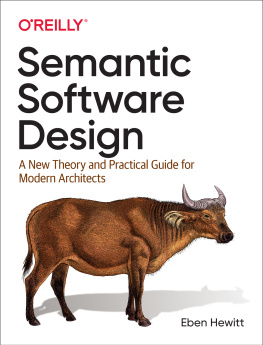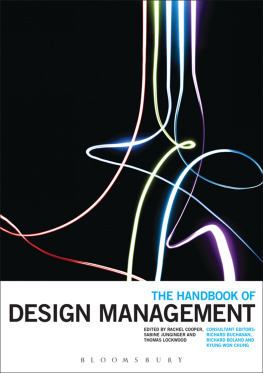Emmitt - Design Management for Architects
Here you can read online Emmitt - Design Management for Architects full text of the book (entire story) in english for free. Download pdf and epub, get meaning, cover and reviews about this ebook. City: Chichester, year: 2014, publisher: John Wiley & Sons, Incorporated;Wiley-Blackwell, genre: Business. Description of the work, (preface) as well as reviews are available. Best literature library LitArk.com created for fans of good reading and offers a wide selection of genres:
Romance novel
Science fiction
Adventure
Detective
Science
History
Home and family
Prose
Art
Politics
Computer
Non-fiction
Religion
Business
Children
Humor
Choose a favorite category and find really read worthwhile books. Enjoy immersion in the world of imagination, feel the emotions of the characters or learn something new for yourself, make an fascinating discovery.

Design Management for Architects: summary, description and annotation
We offer to read an annotation, description, summary or preface (depends on what the author of the book "Design Management for Architects" wrote himself). If you haven't found the necessary information about the book — write in the comments, we will try to find it.
Emmitt: author's other books
Who wrote Design Management for Architects? Find out the surname, the name of the author of the book and a list of all author's works by series.
Design Management for Architects — read online for free the complete book (whole text) full work
Below is the text of the book, divided by pages. System saving the place of the last page read, allows you to conveniently read the book "Design Management for Architects" online for free, without having to search again every time where you left off. Put a bookmark, and you can go to the page where you finished reading at any time.
Font size:
Interval:
Bookmark:


This edition first published 2014
2007 by Blackwell Publishing Ltd, 2014 by John Wiley & Sons, Ltd
Registered Office
John Wiley & Sons, Ltd, The Atrium, Southern Gate, Chichester, West Sussex, PO19 8SQ, United Kingdom.
Editorial Offices
9600 Garsington Road, Oxford, OX4 2DQ, United Kingdom.
The Atrium, Southern Gate, Chichester, West Sussex, PO19 8SQ, United Kingdom.
For details of our global editorial offices, for customer services and for information about how to apply for permission to reuse the copyright material in this book please see our website at www.wiley.com/wiley-blackwell .
The right of the author to be identified as the author of this work has been asserted in accordance with the UK Copyright, Designs and Patents Act 1988.
All rights reserved. No part of this publication may be reproduced, stored in a retrieval system, or transmitted, in any form or by any means, electronic, mechanical, photocopying, recording or otherwise, except as permitted by the UK Copyright, Designs and Patents Act 1988, without the prior permission of the publisher.
Designations used by companies to distinguish their products are often claimed as trademarks. All brand names and product names used in this book are trade names, service marks, trademarks or registered trademarks of their respective owners. The publisher is not associated with any product or vendor mentioned in this book.
Limit of Liability/Disclaimer of Warranty: While the publisher and author(s) have used their best efforts in preparing this book, they make no representations or warranties with respect to the accuracy or completeness of the contents of this book and specifically disclaim any implied warranties of merchantability or fitness for a particular purpose. It is sold on the understanding that the publisher is not engaged in rendering professional services and neither the publisher nor the author shall be liable for damages arising herefrom. If professional advice or other expert assistance is required, the services of a competent professional should be sought.
Library of Congress Cataloging-in-Publication Data
Emmitt, Stephen.
Design management for architects / Stephen Emmitt. Second Edition.
pages cm
Includes bibliographical references and index.
ISBN 978-1-118-39446-5 (pbk.)
1. Architectural design. 2. Architectural practiceManagement. I. Title.
NA2750.E46 2014
720.68dc23
2013038758
A catalogue record for this book is available from the British Library.
Wiley also publishes its books in a variety of electronic formats. Some content that appears in print may not be available in electronic books.
Cover image: www.hisandhersdesign.co.uk
Cover design by Sophie Ford, His and Hers Design
It was during the 1960s that the architectural profession in the UK started to take the issue of management seriously. The RIBAs report The Architect and His Office (1962) highlighted the architects lack of managerial acumen, which resulted in the subsequent publication of many guides, such as the RIBA Plan of Work and Architects Job Book . This early work has been continually revised and updated over the years, providing architects, architectural technologists and technicians with essential guidance to the administration of individual projects. Interest in the management of design has also been growing, with the growth of the design management literature and the evolution of the design manager role within the fields of architecture and construction. Parallel to this has been the growth and evolution of construction management literature, which more recently has started to expand into the areas of design management and briefing. Since the 1960s there have been considerable changes in our approach to the management of construction projects and, despite many good examples of how to manage the processes effectively and professionally, we still see reports urging us to do it better. In addition to the reports and initiatives aimed at the construction sector, there have also been a small number of reports aimed specifically at architects. These have emphasised the need for better management of design activities and design offices, while also raising questions about how, and what, architects should be taught. Whatever our view, it is difficult to ignore the fact that our fellow professionals leave university with a thorough understanding of how to manage projects and commercial enterprises. The result is that architects often find it difficult to relate to their fellow project contributors and frequently find themselves excluded from important decision-making stages at pivotal stages in the life of a project. Architects have a significant part to play in the realisation of creative and exciting buildings, but this is difficult to achieve when positioned outside the management culture. It is imperative in a highly competitive business environment that architects are able to demonstrate professional management skills and leadership competences to their clients and hence retain (or regain) an important place in the planning and management of our built environment. Similarly, it is fundamental that architects are able to communicate with fellow professionals in an environment of greater collaboration and integral working; this requires an understanding and appreciation of management.
As students we spend a great deal of time, effort and emotional energy on learning to design, only to find that on entering practice we are suddenly constrained by many different pressures and controls. Administration seems to be endless and managerial controls too restrictive. Frustration is immediate, not necessarily because there is less time to devote to design, but because we have inadequate grounding in the management of design. My own managerial skills were honed in architectural practice through experience (good and bad), combined with reading many books and articles on management, and, when time permitted, reflection on daily practice. At the time there were few publications that dealt with managing the complexities of design and/or creative architectural practices. Books aimed at architects were primarily concerned with the administration of individual projects, not with the management of creative staff, nor for that matter with the interrelationship between the project portfolio and the office a situation that has changed little over the years. My aim was to write a book that would be pertinent, stimulating and above all useful for architects entering architectural practices, essentially the type of book that I would have welcomed when starting out. The approach taken is to address the synergy between the management of projects (Part One) and the management of design offices (Part Two). It is the interdependency of architects and clients businesses, represented in projects, that colours, shapes and determines the quality of our built environment. The premise is that to be successful we need to ensure that projects are managed professionally and are conceived and delivered within a professionally managed office. It is through effective management of the design office and the project portfolio that client values may be translated into a physical artefact with minimal loss of creativity.
This book has been a complex and lengthy undertaking, bringing together many, often disparate, areas under one set of covers. The ideas and concepts presented were first developed when I was working as a design manager in an architects office and were subsequently refined through interaction with a wide variety of construction professionals in practice and academia. The academic environment has allowed time and space for the ideas to be researched, tested and developed further.
Next pageFont size:
Interval:
Bookmark:
Similar books «Design Management for Architects»
Look at similar books to Design Management for Architects. We have selected literature similar in name and meaning in the hope of providing readers with more options to find new, interesting, not yet read works.
Discussion, reviews of the book Design Management for Architects and just readers' own opinions. Leave your comments, write what you think about the work, its meaning or the main characters. Specify what exactly you liked and what you didn't like, and why you think so.











